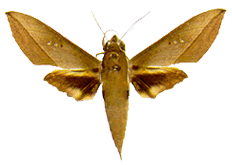|
Theretra
clotho Drury
Sphinx clotho Drury, 1773, Illustr. Ex. Ins., 2: 48.
Theretra clotho Drury; Rothschild & Jordan, 1903: 769.
|

Theretra
clotho ♂
(.83 natural size)
|
Diagnosis.
See T. boisduvali above.
Geographical range. Japan, S. Korea, Indo-Australian tropics to New
South Wales and Loyalty Is.
Habitat preference. This is a common, predominantly lowland
species. During the Mulu survey almost all specimens were taken in
regenerating alluvial forest beside a river.
Biology. The larva has been described by Bell & Scott
(1937) and Dupont & Roepke (1941). Early instars are similar to those
of other species, with the characteristic markings developing as growth
progresses. Again there are green and reddish brown forms of the mature
larva. The green form has a dark green dorsolateral line over the
abdominal segments; within it are the ocellar markings: large on A1, dark
green, ringed yellow and striped with blue; and much smaller,
longitudinally oval, pale yellow patches from A2 to A7. In the reddish
brown form there is a dark dorsolateral line through the ocelli, and
oblique lateral stripes. The anterior ocelli are reddish brown, striped
and ringed with yellow; the posterior pale yellow ocelli are thinly ringed
with purplish. The horn is purplish brown, thick, downcurved.
Recorded host-plants (Bell &. Scott 1937; Dupont & Roepke, 1941;
Pholboon, 1965; Miyata, 1983; Moulds, 1984) are: Amorphophallus,
Colocasia (Araceae); Begonia (Begoniaceae); Dillenia (Dilleniaceae);
Leea (Leeaceae); Hibiscus (Malvaceae); Fuchsia (Onagraceae);
Dendrocnide, Pipturus (Urticaceae); Cayratia, Cissus,
Parthenocissus, Vitis (Vitidaceae).
<<Back
>>Forward <<Return
to Contents page
|

